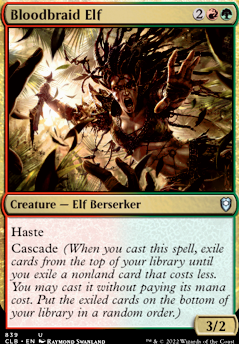Domri Rade
Domri Rade is just a two-of, but it provides a ton of value, especially against grindy, controlling decks. Being only three mana, it's pretty easy to slip Domri Rade through counterspells, and as a planeswalker, it naturally dodges a lot of removal. After Domri Rade is on the battlefield, it draws us an extra creature about every other turn on average, since we have a massive 30 creatures in our deck, which means we have a steady stream of hasty threats to keep attacking our opponent's life total. In a pinch, we can use it to fight a blocker to force through even more damage, and if we ever ultimate, all of our creatures become nearly unbeatable threats. Plus, since Domri Rade is only three mana, it's cheap enough that we can cascade into it with Bloodbraid Elf, which makes it sort of the GR HasteBraid, budget-friendly version of Jund cascading into Liliana of the Veil.
Rancor
Lightning Bolt
If our creatures aren't enough to finish off the game, we've got a couple of spells to force through the final points of damage. Rancor is pretty insane in our deck, giving us a repeatable way of not just pumping our creatures but also giving them trample to get through opposing blockers. With all of our haste threats, a Rancor or two allows us to turn many of our creatures into pseudo-Ball Lightnings, hitting for massive, somewhat evasive damage out of nowhere. As for Lightning Bolt, it does double duty in our deck. In the early game, we can use it to clean blockers out of the way, and then in the late game, we can point it at our opponent's face to finish off the game. It's just too efficient not to play in an aggressive deck with red mana, which is why it's in GR HasteBraid.

